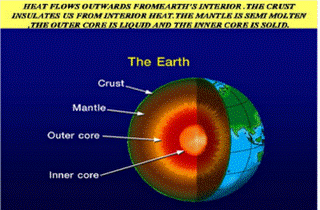





Published on Feb 14, 2025
"Geothermal" comes from the Greek words geo (earth) and thermal (heat). So, geothermal means earth heat. The thermal energy contained in the interior of the earth is called geothermal energy. Geothermal heat originates from earth's fiery consolidation of dust and gas over four billion years ago. The geothermal energy is enormous and will last for several millions of years and is therefore called renewable
The heat from the earth's core continuously flows outward. It transfers (conducts) to the surrounding layer of rock, the mantle. When temperatures and pressures become high enough, some mantle rock melts, becoming magma. Then, because it is lighter (less dense) than the surrounding rock, the magma rises (convects), moving slowly up toward the earth's crust, carrying the heat from below.

Understanding geothermal energy begins with an understanding of the source of this energy-the earth's internal heat. The Earth's temperature increases with depth, with the temperature at the center reaching more than 4200 °C (7600 °F). A portion of this heat is a relic of the planet's formation about 4.5 billion years ago, and a portion is generated by the continuing decay of radioactive isotopes. Heat naturally moves from hotter to cooler regions, so Earth's heat flows from its interior toward the surface.
Because the geologic processes known as plate tectonics, the Earth's crust has been broken into 12 huge plates that move apart or push together at a rate of millimeters per year. Where two plates collide, one plate can thrust below the other, producing extraordinary phenomena such as ocean trenches or strong earthquakes. At great depth, just above the down going plate, temperatures become high enough to melt rock, forming magma.3 Because magma is less dense than surrounding rocks, it moves up toward the earth's crust and carries heat from below. Sometimes magma rises to the surface through thin or fractured crust as lava.
However, most magma remains below earth's crust and heats the surrounding rocks and subterranean water. Some of this water comes all the way up to the surface through faults and cracks in the earth as hot springs or geysers. When this rising hot water and steam is trapped in permeable rocks under a layer of impermeable rocks, it is called a geothermal reservoir. These reservoirs are sources of geothermal energy that can potentially be tapped for electricity generation or direct use. Figure 1 is a schematic of a typical geothermal power plant showing the location of magma and a geothermal reservoir.4 Here, the production well withdraws heated geothermal fluid, and the injection well returns cooled fluids to the reservoir.
Typically, geothermal wells are drilled to depths ranging rom 200 to 1,500 meters depth for low- and medium-temperature systems, and from 700 to 3,000 meters depth for high-temperature systems. Wells can be drilled vertically or at an angle. Wells are drilled in a series of stages, with each stage being of smaller diameter than the previous stage, and each being secured by steel casings, which are cemented in place before drilling the subsequent stage. The final production sections of the well use an uncemented perforated liner, allowing the geothermal fluid to pass into the pipe.
The objectives of this phase are to prove the existence of an exploitable resource and to delineate the extent and the characteristics of the resource. An exploratory drilling program may include shallow temperature-gradient wells, "slim-hole" exploration wells, and production-sized exploration/production wells. Temperature-gradient wells are often drilled from 2-200 meters in depth with diameters of 50-150 mm. Slim-hole exploration wells are usually drilled from 200 to 3000 meters in depth with bottom-hole diameters of 100 to 220 mm. The size and objective of the development will determine the number and type of wells to be included in exploratory drilling programs
| Are you interested in this topic.Then mail to us immediately to get the full report.
email :- contactv2@gmail.com |